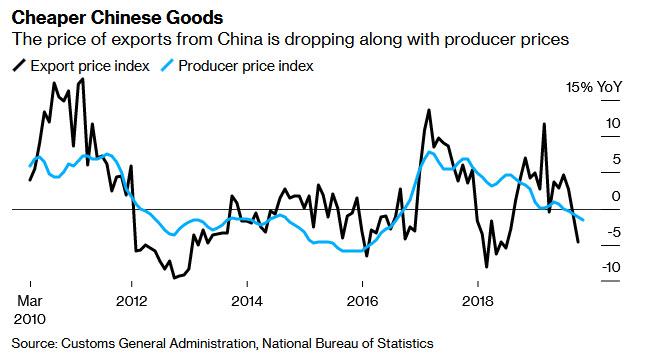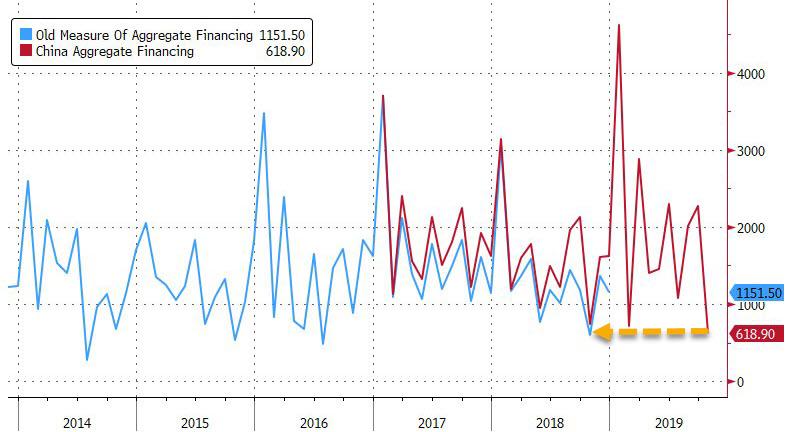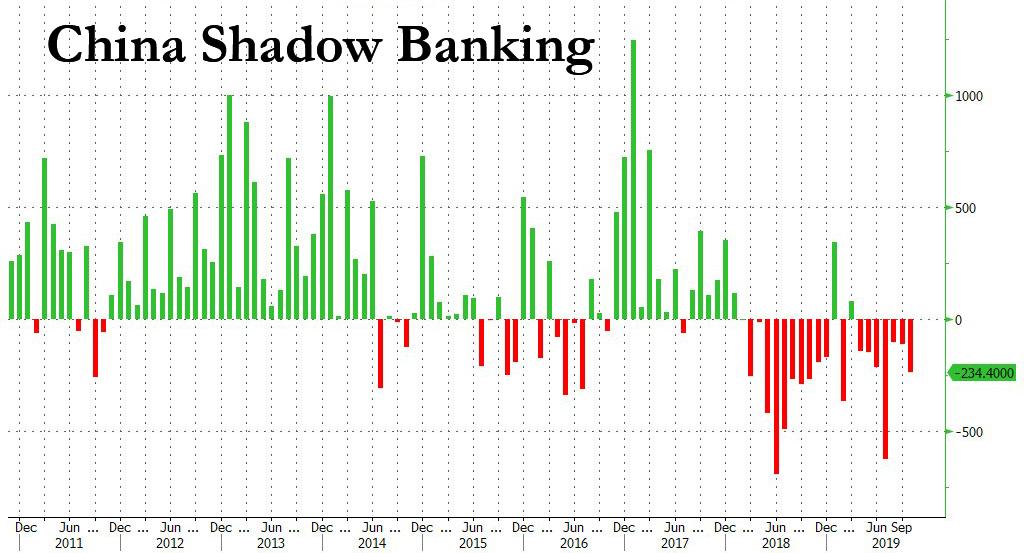中国の与信創造が予想外に急落、最悪のときに生じる
この週末ZeroHedgeはこういうことを見出した、中国では卸インフレ、PPI、が低迷している、これは企業収益には重要で、需要駆動形のインフレが収まっているということだ、10月のデータを見ると、中国の輸出品が3年ぶりの安値になり、世界的にリフレを抑え込むことになるだろう・・・

... will not reverse until Beijing injects another elephant-dose of credit into the Chinese financial system.
・・・・北京政府が中国金融システムにさらなる巨額与信注入を行わない限りこの状況は反転しないだろう。
Just 48 hours later we can confirm that there is zero risk of either a sharp spike in Chinese inflation, or of China flooding the financial system with cheap credit - as it has been known to do during key economic inflection points - because according to the PBOC, China’s credit growth slowed far more than expected in October to the weakest pace since at least 2017 as a continued collapse in shadow banking, weak corporate demand for credit and seasonal effects all signaled that efforts to prop up the economy through bank lending still aren’t working.
このわずか48時間後に、ZeroHedgeはこういうことを確認できた、中国でインフレ急騰の可能性はまったくなく、もしくは金融システムに安価な与信注入も無いだろうーー経済にインフレを引き起こすために重要なことが知れ渡っているーーというのもPBOCによれば、中国の10月与信増加は市場予想よりも遥かに鈍化しており、少なくとも2017年以来の弱さだ、シャドーバンキング資金提供が引き続き急落している、企業の与信需要鈍化と季節的要因で銀行の貸し出しによる経済浮揚の努力は機能していない。
中国中央銀行がAggregate Financingを報告した、かつてのTotal Social Financingに代わる新たな中国の統計だ、これがわずか618.9B人民元($88B)だった、控えめな市場予想の950B人民元を下回った、そして9月の2.27T人民元からなんと72%も下落している、また2018年同月には737.4Bだったのだ。今日発表の数値は2017年に開始した新たな統計のなかでは最低のものだ、古い統計を考慮しても2016年以来の最低与信注入だ!

New CNY loans of 661.3 billion yuan also missed the consensus print of 800 billion yuan, resulting in outstanding CNY loan growth of 11.9% annualized in October, well below the September 13.3% annualized print. As has been the case recently, two thirds of yuan-denominated bank loans were borrowed by households in the month, while the borrowing by non-financial companies was the least in amount since August 2016.
新規CNY貸し出し661.3B人民元は市場コンセンサスの800B人民元を下回るもので、10月のデータは年率11.9%の増加だった、9月の年率13.3%増をしたまわるものだ。最近の調光は人民元建て銀行貸出の2/3は家計向けであり、非金融企業による借金は2016年8月以来の弱さだ。
But it was China's shadow banking that was the main culprit for today's steep total credit drop, which tumbled by 234 billion in October, the second biggest one month drop of the year, and the 7th drop in a row as well 18th of the past 20! Specifically, entrusted loans fell by 66.7 billion yuan, trust loans declined 62.4 billion yuan and undiscounted bankers acceptances fell 105.3 billion yuan.
今日発表の与信急落の主犯は中国シャドーバンキングシステムにあり、10月に234B減らした、一月の下落では今年二番目だ、7か月連続下落であり、過去20か月のうちで18か月が減少だった!特に銀行が仲介するentrusted loansは66.7B人民元減った、trust loansは62.4B人民元減った、そして undiscounted な銀行引受は105.3B人民元減った。

Separately, China's all important M2 rose 8.4% yoy in October, in line with expectations, and just shy of the all time low print.
季節的に10月は銀行貸出が前月比で減るが、この原因は国慶節休暇によるビジネス活動低下によるものだ、地方政府の目的限定債務とシャドーバンキングがともにヘリ、下落トレンドを強めている、結果として中国経済では必須のクレジットインパルスがずっと低下している。話は変わるが、中国の重要な全M2は10月にYoYで8.4%増加した、これは予想通りだった、過去最低量からほんの少し増えている。
"The data itself is kind of expected in terms of the trend,” Commerzbank analyst Zhou Hao said, nothing however that the market is concerned about two things - that it hit another record low (for the current series) and that this means that banks seem to have no place to funnel money after lending to smaller and private firms earlier waned. The deflationary omen also pushed China’s 10 year government bond yield lower by 5 basis points to 3.22%.
「データ自身はトレンドから予想されたものだ」、とコメルツバンクアナリストのZhou Haoは言う、しかしながら、市場は2つのことを懸念している、一連の数値のなかで過去最低になったこと、そして銀行は民間小企業への資金供給を弱めていることだ。不吉なデフレ予兆で中国10年債の金利は5BPS下がり3.22%となった。
Others, paradoxically, saw in the data which confirms that the PBOC is unable to dramatically expand credit a sign that the PBOC would instead seek to ease further, even though as we noted over the weekend, soaring Chinese pork prices make that very unlikely: "The anemic credit data -- coming on the heels of data showing deepening deflation in the industrial sector -- reinforce our expectations that the PBOC will continue to ease monetary policy" said Bloomberg economists Chang Shu and David Qu.
データには他にも不可解なことがある、PBOCはさらなる緩和方策を求めながら劇的な与信拡大をできないのだ、週末に我々が指摘したことだが、中国の豚肉価格高騰は望ましいことではない:「弱い与信データを見るとーー産業界では大きなデフレが生じているーー我々の予想を補強するものとして、PBOCは引き続き金融緩和政策を継続するだろう」とブルームバーグのエコノミストChang ShuとDavid Quは伝える。
Meanwhile, as Goldman notes, despite the targeted RRR cut on October 15, the 7-day repo rate remained relatively high at 2.8% in October. As such, the major tool of loosening is more likely to be administrative measures (i.e. window guidance) to boost broad credit growth. The administrative pressures which can affect both the supply of and demand for credit likely came down in October after the government tried successfully to boost September credit and activity data.
それと同時にGoldmanはこう主張する、10月15日に目標RRRを引き下げたが、10月において、7 day repo rateは引き続き2.8%と高いままだ。ということは、主要な緩和策は行政指導にとどまり( 変動幅ガイダンス)これで与信増加を試みている。与信需給を高めようとする当局圧力は10月には弱かった、9月の与信活動データを見て政府は試みたにもかかわらずだ。
踏んだり蹴ったりの状況で、中央銀行の緩和能力にも限界がある、データ変動が大きく11月のCPIデータはYoYでみると高いかもしれない。しかしTotal Social Financing が弱く経済活動成長も弱い中で、政策立案者は緩和圧力を強めるだろう。結果として、ゴールドマンの予想では、来年の国債発行を今年に前倒しすると見ている、ただし発行規模は限定的でありその理由は
- concerns about inflation,
インフレ懸念
- policy prudence to ensure the investment projects are economically sensible, and
投資プロジェクトへの政策規律が経済的に良識のあるものだ、そして
- better prospects of the US-China trade negotiations.
米中貿易交渉に良い印象を与えるだろう
しかしながら今の所、さらなる失望を予感させる、Wall Streetも北京政府もともに初めてGDP成長率がQ4に6%を切ることに身構えている(たぶん、5.9%だろう)。




